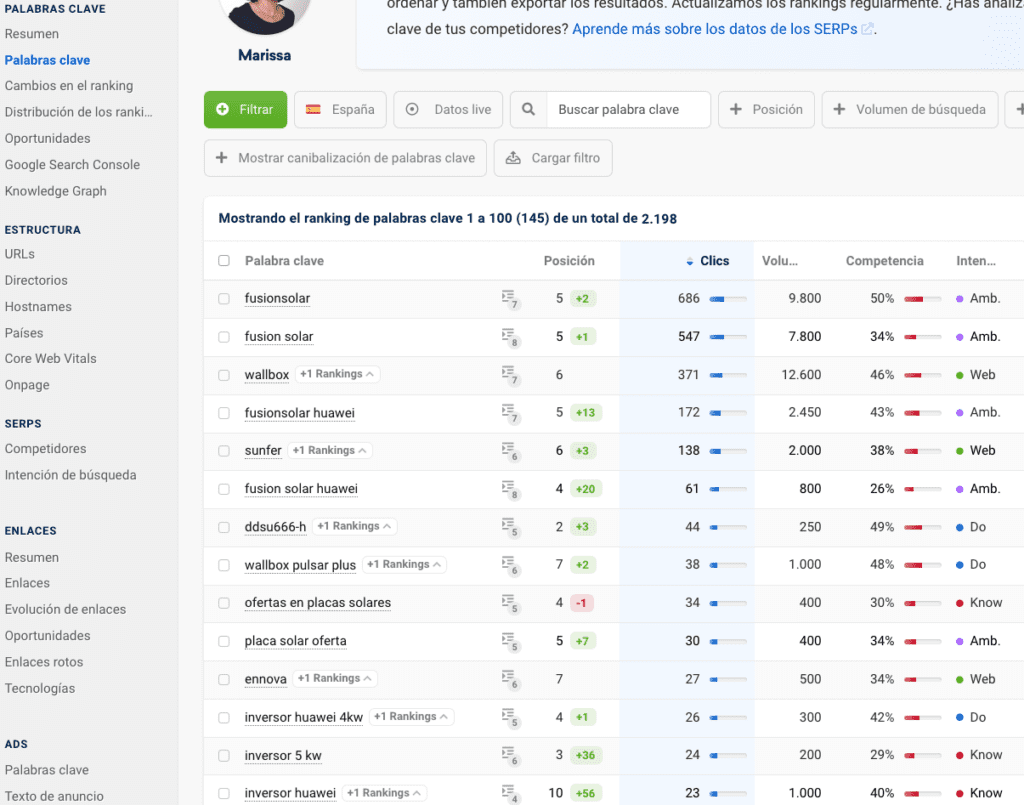SEO competition analysis is a fundamental process when we are trying to audit the status of a project in comparison to the rest.
Thanks to this type of analysis we can extract certain insights both on page and off page that can be a starting point for designing our SEO strategies.
First, determine who our organic competitors are
Determining what our organic competition is is the first step we must face.
There are different tools that can suggest a list of competitors based on, for example, the number of keywords shared by different projects.
One of them is Sistrix, where thanks to its “competitors” module, it shows us at a first glance, the classic ball graph where the organic strength of different competitors is contemplated depending on their positioned keywords and the visibility index.

The important thing here is not to take this information as a mantra, but rather that we ourselves investigate those competitors that we are most interested in analyzing.
If we take the photovoltaic energy sector as an example, we can take a series of highly representative keywords that have notable search demand, such as “solar panels” and “solar self-consumption”.
By analyzing the organic results for this series of queries, we can see how different players are systematically repeated among the first results. There we have a good starting point to begin our analysis.
We can do the same exercise for those results that are not, for example, in the top 5/top 10 or even top 15 results, since in many cases we will find competitors who are doing things very well but perhaps do not have the same level of authority.
Organic visibility analysis
To determine the exact point at which each competitor is in terms of organic visibility, we can rely on the Sistrix visibility index, which will give us a fairly faithful image of the status of each project.
In the following image we can see the status of four projects, one being a top player in the market and the rest in a position higher than ours, which can give us a series of insights to work on in our project.
Sometimes we can find peaks of decreases and/or increases in visibility. It is a good opportunity to see if there have been updates to the Google algorithm during those periods or if significant changes were made within the site.

Analyze sites the good old way
I think there is no better way to analyze an organic competitor’s strategy than to navigate through each of the websites.
This will give us valuable information on aspects such as:
-
How the information architecture is presented: how its pages are hierarchized and structured based on the different search intentions they intend to attack and what levels of depth the transactional landings present.
-
What type of keywords and semantics do you intend to attack in your transactional landing pages?
-
How they structure their pages to encourage conversions (inclusion of CTAs, forms, copies, product listings, etc.)
-
Content strategy: Determine whether content is published with the intention of reaching users in the early stages of the funnel. Do you publish content of an informational nature? Do they do it with some regularity? Do you pursue any recruitment strategy?
All this analysis of SEO competitors will have already given us a set of ideas that we can carry out in our strategy.
Analyze your organic positioning in detail
Once we have seen this series of aspects in detail, we can do a more exhaustive analysis of what rankings the target keywords occupy in the sector segmented by the main verticals of each website.
For this, we can rely on Sistrix again. By selecting domain by domain in the keywords section we can download those keywords for which each project is positioned.
We must pay attention to what URL structure the site in question uses. For example, continuing with the example of projects related to photovoltaic energy, we can find a competitor that supplies “solar kits”, “solar panels” and “batteries” and that in its URL structure is differentiated by folder for each of them. these verticals /solar-kits/, /solar-panels/ and /batteries/ (each project will have its own different casuistry and the way of filtering the data will be different).

By downloading this data into an Excel, we can filter by those URLs that contain each of the URLs that we are interested in analyzing and see how many keywords are positioning in top 1, top 3, top 10, etc.
This will allow us, among other things, to see the weight that brand keywords have compared to the total, determine the search volumes of both brand and generic keywords and analyze the status of the project for each of its main verticals.
